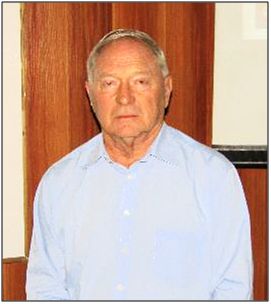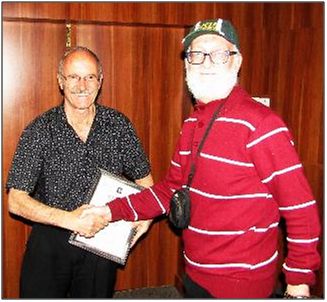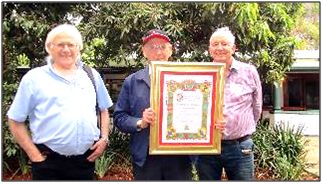


Curtain Raiser: Murray Webb: "A brief history of the origins of North Korea, and my recent bizarre visit there"
This month's Curtain Raiser talk was by Murray Webb, who recently had the chance to visit North Korea with his son, and whilst there experienced some bizarre sights as a Westerner.

Murray Webb.
Korea can trace its roots back to 8,000BC, when, during this time, it was ruled by dynasties and warlords that came and went. Leading up to about 1900, the Korea of old was eventually unified and then consolidated under one strong leader. North Korea is about 120kmę in size which equates to the size of Limpopo Province, whilst South Korea measures 100kmę in size, and equals the size of the Province of KwaZulu-Natal. Korea has a combined population of 75 million 'Seouls', compared to 9 million in our two provinces.
Korea would always exist in the shadows of China, but Japan made the first move during its expansion campaign when it turned Korea in to a Japanese Protectorate, eventually annexing it in 1910. During its 37-year rule, the Japanese attempted to abolish the Korean culture and language. The Japanese annexation came to an end in 1945, when Soviet forces invaded Korea from the north and US Forces from the south. The two forces met for the first time at the 38th parallel and finally departed in 1947, when newly elected leaders took over in the north and the south. The South was ruled in a free enterprise system by Sygman Rhee, whilst the North opted for Communist rule under Kim il Sung. The Korean War of 1950-1953 involved 20 nations on both sides and began when the North invaded the South, capturing Seoul, and pushed deeper into the south. The US retaliated when they organised a UN Force comprising of US, British, French, Australian, New Zealand and South African forces. General Mc Arthur was in overall command of the US 8th Army and managed to drive back the enemy, retaking Seoul, crossing over the 38th Parallel until being met by a force of 500,000 Chinese troops and a harsh winter with temperatures as low as -40 C. In 1951, "peace" talks were started, but the fighting would continue for two more years, until July 1953, when an Armistice was signed.
Fast forward 65 years, and Murray and Andrew Webb touched down in Pyongyang following a flight from Beijing. Breezing through customs and immigration, the pair had their cellphones carefully examined and their passports and visas were taken into custody for the duration of their five-day stay. A drive along the virtually deserted highway through several checkpoints took them to the magnificent statues of Kim il Sung and his son, Kim Jong il where they were asked to purchase bouquets and place them at the foot of the statues and then bow. From there, they were taken to the state owned hotel and were not permitted to leave.
The country is mostly made up of grey, creaky infrastructure and is clean. A strong anti-American sentiment has remained prevalent since the end of the Korean War and the population gets bombarded with relentless propaganda through loudspeakers fitted to "radio cars", and via the state owned radio and television services. The country maintains a strong military presence and guards are present everywhere. To try and escape their three minders, a round of golf was played, but all too soon an escort appeared that followed them.
A trip to the circus saw the two "Westerners" sit down for the show, no sooner to be joined by yet another escort, but at no time did the pair feel that this form of control was oppressive, but merely a tedious and time consuming red tape show.
Whilst travelling on the 200km long, paved, four lane highway, a single car, usually police or military, was passed every 5 kilometres or so. At the half-way mark, the tiny "Peace bus" stopped at an "Engen-type half-stop" where a table and chairs were whipped out and set up at the side of the highway to serve tea. Korea manufactures three types of cars, the "Peace bus", Russian jeeps and the "Korean Bakkie", a sort of 1930's lawnmower tractor that pulls a trailer. After their bizarre 5-day visit came to an end, they were able to depart this communist relic in relative safety.
Main Lecture: "Why we won". Viewpoints of a South African combat officer in Angola. - Colonel (Ret.) SA Army, Jan Malan, PVD, SM, MMM.

Col Malan receving his certificate for the best lecture of 2017 from chairman Hamish Paterson.
For the second time in succession, Colonel Jan Malan gave a very interesting talk, where he discussed the viewpoints of the SADF in the 1980's during the border conflict and why they won. The South African Defence Force (SADF) of the late 1980's was a formidable fighting force. It was moulded from years of low and high intensity fighting in South West Africa (now Namibia) and Angola.
Various wars have been fought since 1652, and during the Border Wars from 1960-1990, the enemy this time was a Communist inspired force intent on destroying a Christian based home land. It was war and every loyal and right-thinking South African was ready to put their lives at stake to protect it. It did not only ask for two years of National Service, but even time in the Citizen Force and Commandos. The time it was the right thing to do. The SA Army would win almost all battles their units encountered during the Bush War. That is an undisputable fact. It operated like a well-oiled machine. The SADF consisted of a well-structured and well-managed system, where boys were turned into men and you became the prestige in the eyes of your family and community. It was the chance for a young man to show his character. Some of the contributing factors included a strict selection criteria and a most rigorous training syllabus where suitable leaders were chosen to lead from the front on all levels. Discipline included strict and professional rules, with very little room being left for mistakes. During the 3 months basic training, a lot of practice went in to learning to be on time (7 minutes before the time), listening to commands, to concentrate and to execute orders with precision. The typical military command includes the 5 "Ws": Who, What, Where, When and Whereafter.
After discipline comes SYSTEM. The SADF's training programme was very practical and the same for everyone and live ammunition was used throughout training. Sporting activities to hone team work ranged from school cadets to rugby and athletics and all teachers were sent to the School of Infantry before being posted back. In the Army, everybody started climbing the ladder from the bottom and during his second year of training, a recruit would experience a lot of self-actualisation in preparedness for actual combat operations. Despite facing a total international arms embargo, the SADF was able to produce world class WEAPONRY that was ideally suited for local operational conditions. Armoured, anti-mine vehicles included the Ratel, Buffel and Rooikat and G5 and G6 long range guns. There were also field medical systems, Bateleur rocket launchers, Olifant tanks, anti-aircraft systems and Withings recovery vehicles. The SADF's military hardware eventually turned into a self-sufficient fighting mechanism that became so good that it created export opportunities which in turn made us proud and gave us self-confidence!!
The SADF made use of the best COMMAND CONCEPTS of mobile warfare which it took from the German Wehrmacht and Israeli Army, and applied these tactics locally on how to beat the opponent. Command initiatives included Auftragstaktik (High tempo chain battles) Bewegligkeit (Envelopment and deep operations), Kesselschlagtung (Focus of main effort) and Schwehrpunkt (Movability). Officers were taught to engage quickly through the so-called OODA (Observation, Orientation, Decision and Action) cycle, enabling them to surprise the enemy commanders by our speed of decision making and action. The Bush War happened before the era of cellphones, e-mail, and the internet. The mass media got directly involved and COMMUNICATION then was direct and based on a "must know" basis. Direct command was the name of the game. Everyone knew who their direct commander was and knew the implications of the different command affiliations. On each level, warning orders were issued, followed by orders, then came training and rehearsals, where mistakes could be addressed immediately. Commanders spoke to their troops on every occasion, during parades, in order groups, at field church services and informally. This created trust.
By 1975, it became clear that the SADF's weaponry and training methods were not up to scratch. In 1982, after Operation Protea, 61 Mech. Battalion Group started developing integrated techniques and joint battle drills with standard commands as it was realized that the war would escalate. In 1985-86, I was responsible for the training of Permanent Force and Citizen Force Officers in TEWT's (Tactical exercises without troops). Exercises involved recruits training against each other (two-sided), thinking as the enemy and using live ammunition with full fire coordination. The SADF realised that they would be fighting in the African Bush and against a numerically superior enemy. This was before the availability of GPS. "Do what you can with what is available", and " 'n Boer maak 'n plan". This was what they did!!
Richard Schütte
Newsletter Scribe
Congratulations go to MHS committee Member, David Scholtz, in recognition for his contribution towards promoting and interest in the Anglo-Boer War. David received a framed certificate at Kedar Lodge on the 13th of October.

David Scholtz, center, holding the certificate of recognition.
There will be a collection tin for donations to the SA Legion's annual funding appeal at the November lecture in Johannesburg.
Sarah Welham from the Johannesburg Heritage Foundation has started a new group called -
Friends of the Cemeteries They are asking for help on
Friday 9th of November at Braamfontein Cemetery at 10h00
Poppies will be placed on the graves/memorials of WWI soldiers in both the Jewish and main
sections of the cemetery. There will be quite a bit of walking involved, so hats, comfortable
shoes and water are recommended. More details from welham@icon.co.za
Postal delays mean that the newsletter sometimes arrives after the lecture date has passed. Please consider changing to an e-mailed newsletter - let Joan know at joan@rfidradar.com or remember that the Johannesburg lectures are on the SECOND THURSDAY of a month.
Cape Town: Thursday 8th November Johan van den Berg The "Tank Battle" of Cambrai: Fact or Myth JOHANNESBURG:
Ditsong Museum next to Zoo at 8pm
SAMHSEC:
Branch contact details
For Cape Town details contact Johan van den Berg 021-939-7923 warbooks@mweb.co.za
For Eastern Cape details contact Malcolm Kinghorn 041-373-4469 culturev@lantic.net
For Gauteng details contact Joan Marsh 010-237-0676 joan@rfidradar.com
For KwaZulu-Natal details contact Roy Bowman 031 564 4669 bowman.roy93@gmail.com
* NOTE*
Fast mirror and backup site BOOKMARK
FOR REFERENCE Main
site * NOTE*